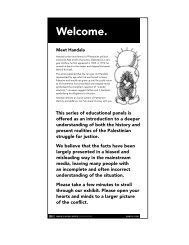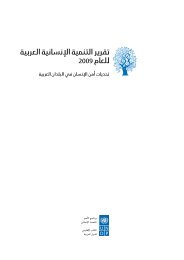arab human development report 2003 - Palestine Remembered
arab human development report 2003 - Palestine Remembered
arab human development report 2003 - Palestine Remembered
- No tags were found...
You also want an ePaper? Increase the reach of your titles
YUMPU automatically turns print PDFs into web optimized ePapers that Google loves.
nowadays can provide the means to expandthe scope of <strong>human</strong> freedoms, enhance the capacityto guarantee those freedoms throughgood governance and achieve the higher moral<strong>human</strong> goals of justice and <strong>human</strong> dignityContrasting this type of society with thestate of knowledge in Arab countries, theReport looks carefully at the characteristics ofthe two main components of the knowledgeacquisition system: diffusion and production.KNOWLEDGE DIFFUSION: BLOCKSIN EDUCATION, BRIGHT SPOTS INTHE MEDIAKey knowledge dissemination processes inArab countries, (socialisation and upbringing,education, the media and translation), facedeep-seated social, institutional, economicand political impediments. Notable amongthese are the meagre resources available to individuals,families and institutions and the restrictionsimposed upon them. As a result,these processes often falter and fall short ofpreparing the epistemological and societal environmentnecessary for knowledge production.Studies indicate that the most widespreadstyle of child rearing in Arab families is the authoritarianmode accompanied by the overprotective.This reduces children’sindependence, self-confidence and social efficiency,and fosters passive attitudes and hesitantdecision-making skills. Most of all, itaffects how the child thinks by suppressingquestioning, exploration and initiative.Impressive gains in the quantitative expansionof education in Arab countries in the lasthalf of the 20 th century are still modest in comparisonwith other developing countries orwith the requirements of <strong>human</strong> <strong>development</strong>.High rates of illiteracy among women persist,particularly in some of the less developedArab countries. Many children still do nothave access to basic education. Higher educationis characterized by decreasing enrolment,and public spending on education has actuallydeclined since 1985.In all cases, nevertheless, the most importantchallenge facing Arab education is its decliningquality.The mass media are the most importantagents for the public diffusion of knowledgeyet Arab countries have lower informationmedia to population ratios (number of newspapers,radio and televisions per 1000 people)compared to the world average. There are lessthan 53 newspapers per 1000 Arab citizens,compared to 285 papers per 1000 people indeveloped countries.In most Arab countries, the media operatein an environment that sharply restricts freedomof the press and freedom of expressionand opinion. Journalists face illegal harassment,intimidation and even physical threats,censorship is rife and newspapers and televisionchannels are sometimes arbitrarily closeddown. Most media institutions are stateowned,particularly radio and television.The last two years, however, have seensome improvements in the Arab informationenvironment, brought about by dawning competition.More independent-minded newspapershave appeared, challenging the iron gripof the older, state-supported press on politicalopinion, news and information. With basesabroad, these papers can escape state censorship.Some private satellite channels havestarted to contest the monopoly of state channelsover the broadcast media. The most importantcharacteristic of this new informationmovement is that it broadcasts in Arabic,thereby addressing the largest segment of theArab audience.In terms of infrastructure, the newer informationchannels benefit from the considerablegroundwork that a number of Arab countrieshave laid. However, the general trend gravitatestowards the lowest indicators in worldstandards. The number of telephone lines inthe Arab countries is barely one fifth of that indeveloped countries. Access to digital media isalso among the lowest in the world. There arejust 18 computers per 1000 people in the region,compared to the global average of 78.3percent per 1000 persons and only 1.6 per centof the population has Internet access. Theseindicators scarcely reflect a sufficient level ofpreparedness for applying information technologyfor knowledge diffusion.Translation is one of the important channelsfor the dissemination of information andcommunication with the rest of the world. Thetranslation movement in the Arab world, however,remains static and chaotic. On average,The most importantchallenge facing Arabeducation is itsdeclining quality.The last two yearshave seenimprovements in theArab informationenvironment broughtabout by dawningcompetition.EXECUTIVE SUMMARY 3







